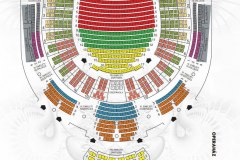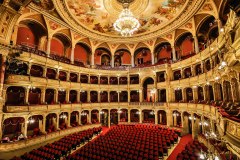Timeless Contemporary
March 2026 | ||||||
|---|---|---|---|---|---|---|
Mo | Tu | We | Th | Fr | Sa | Su |
András Lukács - Jiří Kylián - Hans van Manen
Timeless Contemporary – Whirling, Petite Mort, Six Dances, Trois Gnossiennes
Running time: 1 hour 30 minutes, including one intermission
Age restriction: The performance is not recommended for children under 16 years of age.
Whirling - András Lukács / Philip Glass
Whirling, a pas de deux by András Lukács, a former soloist with the Hungarian National Ballet is set to the music of Philip Glass, one of the greatest masters of repetitive music. The nearly fluid movement, the infinite harmony among the dancers and the unique style of choreography make the scene both quite exhausting and complicated. In 2010, the Hungarian National Ballet commissioned Lukács to create an expanded version for nine pairs. Tastefully and thrillingly combining elements based on classical techniques with modern devices, Lukács primarily creates plotless choreographies that are highly expressive. In Whirling, along with the music, the spiralling movements of the dancing superbly illustrate a vortex of water: the water into which the suicidal Virginia Woolf casts herself to the music of Philip Glass in the film The Hours.
Trois Gnossiennes - Hans van Manen / Erik Satie
Built around the magically beautiful music of Erik Satie, Hans van Manen’s Trois Gnossiennes draws a picture of a unique relationship. This double portrait painted with sensitive brushstrokes flashes with images of trust, submission and dominance, and relativity and interdependence. Masterfully alternating between lyrical and grotesque elements and weaving together memorable human traits, van Manen depicts monologues and dialogue, as well as symbolic moments of a relationship rich in intimate profundities. The bravura elevation of simple poses to the level of acrobatics and the enigmatic and fantastic play with a living body that goes limp make this short but dense work an unforgettable one.
Petite Mort - Jiří Kylián / Wolfgang Amadeus Mozart
Jiří Kylián has always admired Mozart; over the course of his career, he has created a number of choreographed to the composer's music, including one from 1991 that paid homage to the genius of the 200th anniversary of his death.
Featured in this uniquely atmospheric ballet are six women, six men and six swords. In addition to the weapons, other props include black, baroque-style clothing and bizarre crinolines. The symbolic image in the dance piece presents a world where aggression, sexuality, silence, music, vulnerability, interdependence and eternal human beauty exist together in their own sense of poetry. This ballet from the choreographer's mature period is characterised by daring visuals, superb dance performances, elegance and style and has featured in the Hungarian National Ballet's repertoire since May 2013.
Six Dances - Jiří Kylián / Wolfgang Amadeus Mozart
"I've decided that I cannot simply create a dance series reflecting the composer's sense of humour and music genious. Instead, I've choreographed six visibly confusing scenes..." (Jiří Kylián)
In Kylián's ballet, Mozartian playfulness and absurd reality are transplanted into the language of movement. It was not a story that he set out to create, but rather a dance piece constructed out of the absurd situations encountered by heroes in powdered wigs who sometimes act irrationally and awkwardly: the very dictionary definition of the word "burlesque". From the first moment, the eight dancers take the stage like they are stepping out of a wax museum from Mozart's own era, and then the innovative freshness and dizzying dynamic of the choreography makes them ever more modern: timeless heroes of Kylián's absurd creative world.
Program and cast
Whirling
Solo girl: Jessica Leon Carulla, Lea Földi
Solo boy: Iurii Kekalo, Gergő Ármin Balázsi
Duo: Yuki Wakabayashi, Mahillo Carlos Taravillo, Nadezhda Sorokina, Kamill Kökény-Hámori
Trio: Rita Hangya, Kristóf Morvai, Vince Topolánszky, Janka Dobra, Valerio Palumbo, Yago Guerra
Girls: Cecilia Dosio, Aglaja Sawatzki, Adrienn Horányi, Erina Yoshie, Yuiko Adachi, Matilde Noemi Barbaglia, Dóra Szelényi, Lisa Roselli, Nika Kristina Crnic, Ashlee Crowe, Rachel Quintao, Natsuna Oya
Boys: Dávid Molnár, Tymofiy Bykovets, Gaetano Cottonaro, Christian Mathot, Mattheus Bäckström, Josue Moreno Lagarda, Alexander Smith, Takaaki Okajima, Luca Massara, Demeter Kóbor
Choreographer: András Lukács
Costume designer: Zsóka Szomolányi
Costume designer: Mónika Herwerth
Lighting designer: András Lukács
Ballet master: Marianna Venekei
Trois Gnossiennes
Solo girl: N. N.
Solo boy: N. N.
Featuring on Piano - Yevhenii Fomin
Choreographer: Hans van Manen
Set designer: Hans van Manen
Costume designer: Joop Stokvis
Costume designer: Hans van Manen
Lighting designer: Jan Hofstra
Rehearsals supervised by Igone de Jongh
Ballet master: Mária Aradi
Ballet master: Tamás Solymosi
Petite Mort
Conductor: Paul Marsovszky, Johannes Marsovszky
Girls: Stefanida Ovcharenko, Anna Krupp, Aliya Tanykpayeva, Tatyjana Melnyik, Adrienn Pap, Yuliya Radziush, Théa Solomon, Adema Omarova, Soobin Lee, Maria Yakovleva, Miyu Takamori, Maria Beck
Boys: Daniyar Zhumatayev, Vlagyiszlav Melnyik, Louis Scrivener, Viachaslau Hnedchyk, András Rónai, Dmitry Timofeev, Dumitru Taran, Auguste Marmus, Mikalai Radziush, Boris Zhurilov, Motomi Kiyota, Raffaello Barbieri
Featuring on Piano - Yevhenii Fomin, György Lázár, Nataliya Pinelis
Choreographer: Jiří Kylián
Set designer: Jiří Kylián
Costume designer: Joke Visser
Lighting designer: Joop Caboort
Lighting designer: Joost Biegelaar
Ballet master: Shirley Esseboom
Six Dances
Conductor: Paul Marsovszky, Johannes Marsovszky
Girls: Diana Kosyreva, Claudia García Carriera, Katerina Taraszova, Kristina Starostina, Elena Sharipova, Nutsa Chekurashvili, Anastasiia Konstantinova, Olha Skrypchenko
Boys: Riku Yamamoto, Dmitry Zhukov, András Szegő, Francesco Sardella, Alberto Ortega de Pablos, Nathaniel Lillington, Maxim Kovtun, Ricardo Vila M.
Megastars: Lilia Kaliko, Kateryna Horiaieva, Maxim Kovtun, Ricardo Vila M., Boris Myasnikov, Antonio Manganiello
Choreographer: Jiří Kylián
Set and costume designer: Jiří Kylián
Lighting designer: Joost Biegelaar
Lighting designer: Jiří Kylián
Lighting designer: Joop Caboort
Ballet master: Shirley Esseboom
Ballet master: Yvan Dubreuil
Hungarian State Opera
STANDING ROOM TICKETS - INFORMATION IN CASE OF A FULL HOUSE!
If all the seats are sold out for the selected time, but you still want to see the production on that day, 84 of the extremely affordable standing seats will be sold at the theatre, 2 hours before the start of the performance, with which you can visit the gallery on the 3rd floor. Tickets can be purchased at the ticket office of the Budapest Opera House. We would like to draw your attention to the fact that the stage can only be seen to a limited extent from the standing places and the side seats, but at the same time, following the performance is also supported by television broadcasting on the spot.
The Opera House is not only one of the most significant art relic of Budapest, but the symbol of the Hungarian operatic tradition of more than three hundred years as well. The long-awaited moment in Hungarian opera life arrived on September 27, 1884, when, in the presence of Franz Joseph I. the Opera House was opened amid great pomp and ceremony. The event, however, erupted into a small scandal - the curious crowd broke into the entrance hall and overran the security guards in order to catch a glimpse of the splendid Palace on Sugar út. Designed by Mikós Ybl, a major figure of 19th century Hungarian architecture, the construction lived up to the highest expectations. Ornamentation included paintings and sculptures by leading figures of Hungarian art of the time: Károly Lotz, Bertalan Székely, Mór Than and Alajos Stróbl. The great bronze chandelier from Mainz and the stage machinery moda by the Asphaleia company of Vienna were both considered as cutting-edge technology at that time.
Many important artists were guests here including Gustav Mahler, the composer who was director in Budapest from 1887 to 1891. He founded the international prestige of the institution, performing Wagner operas as well as Magcagni’ Cavalleria Rusticana. The Hungarian State Opera has always maintained high professional standards, inviting international stars like Renée Fleming, Cecilia Bartoli, Monserrat Caballé, Placido Domingo, Luciano Pavarotti, José Cura, Thomas Hampson and Juan Diego Flórez to perform on its stage. The Hungarian cast include outstanding and renowed artists like Éva Marton, Ilona Tokody, Andrea Rost, Dénes Gulyás, Attila Fekete and Gábor Bretz.

 EN
EN DE
DE IT
IT FR
FR ES
ES RU
RU JP
JP RO
RO
 Seating plan
Seating plan 